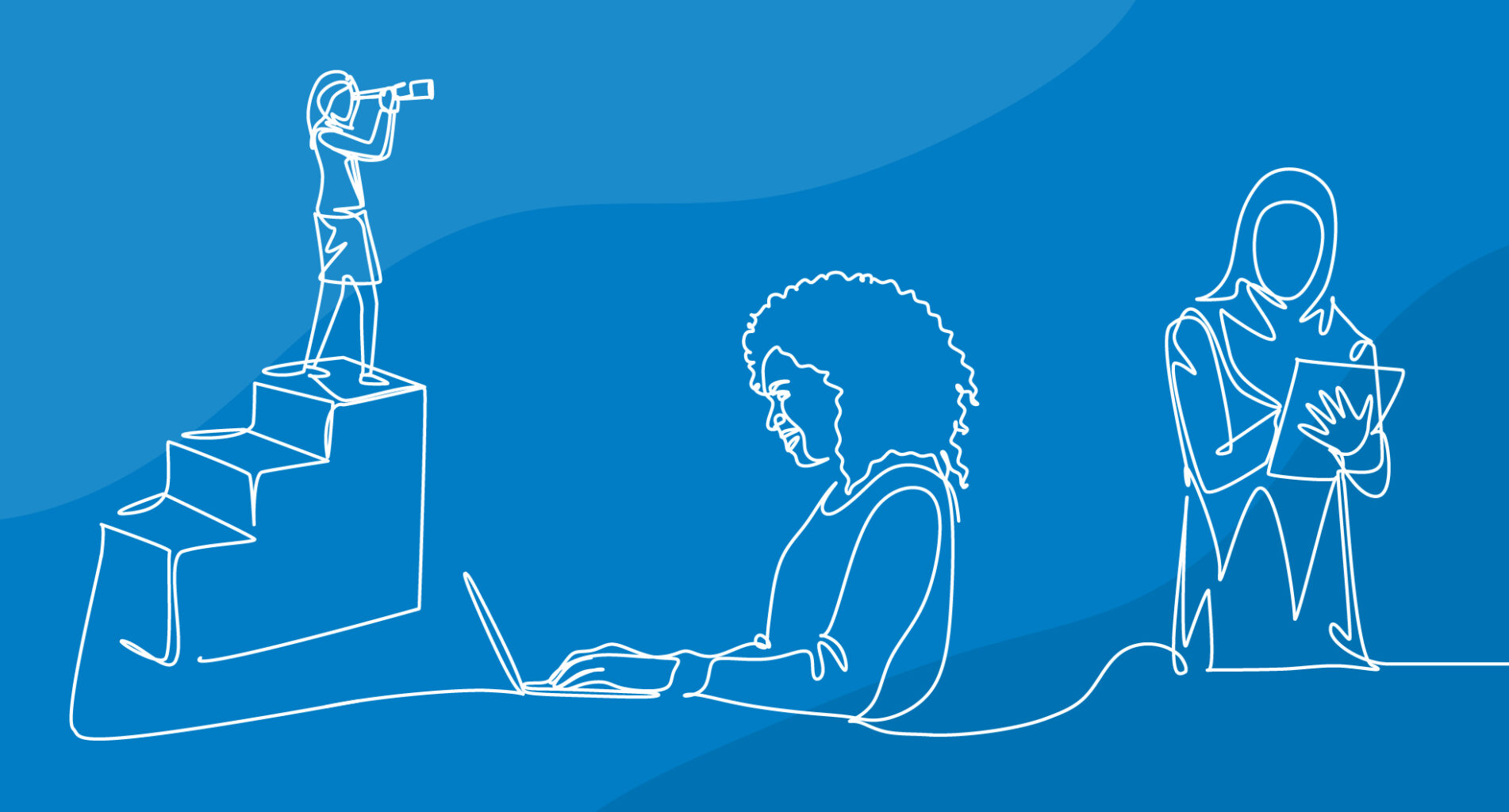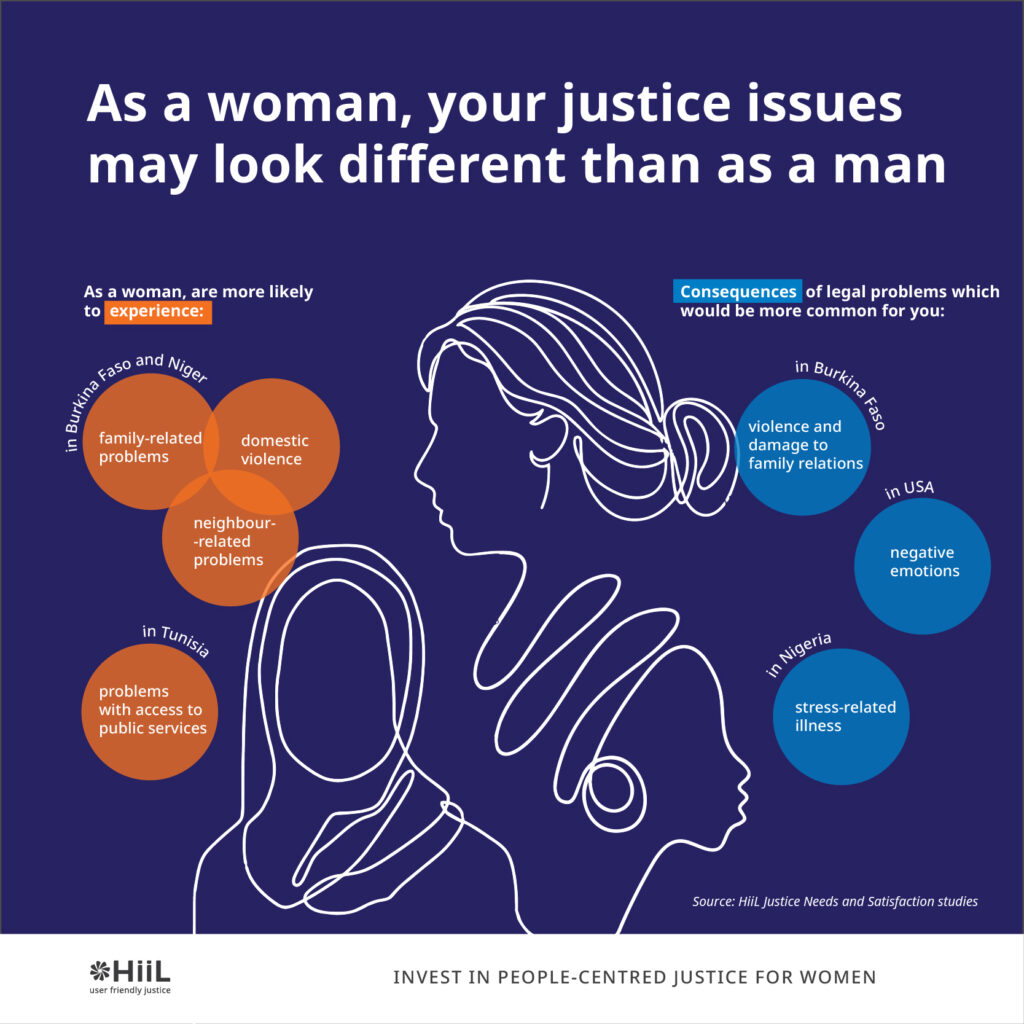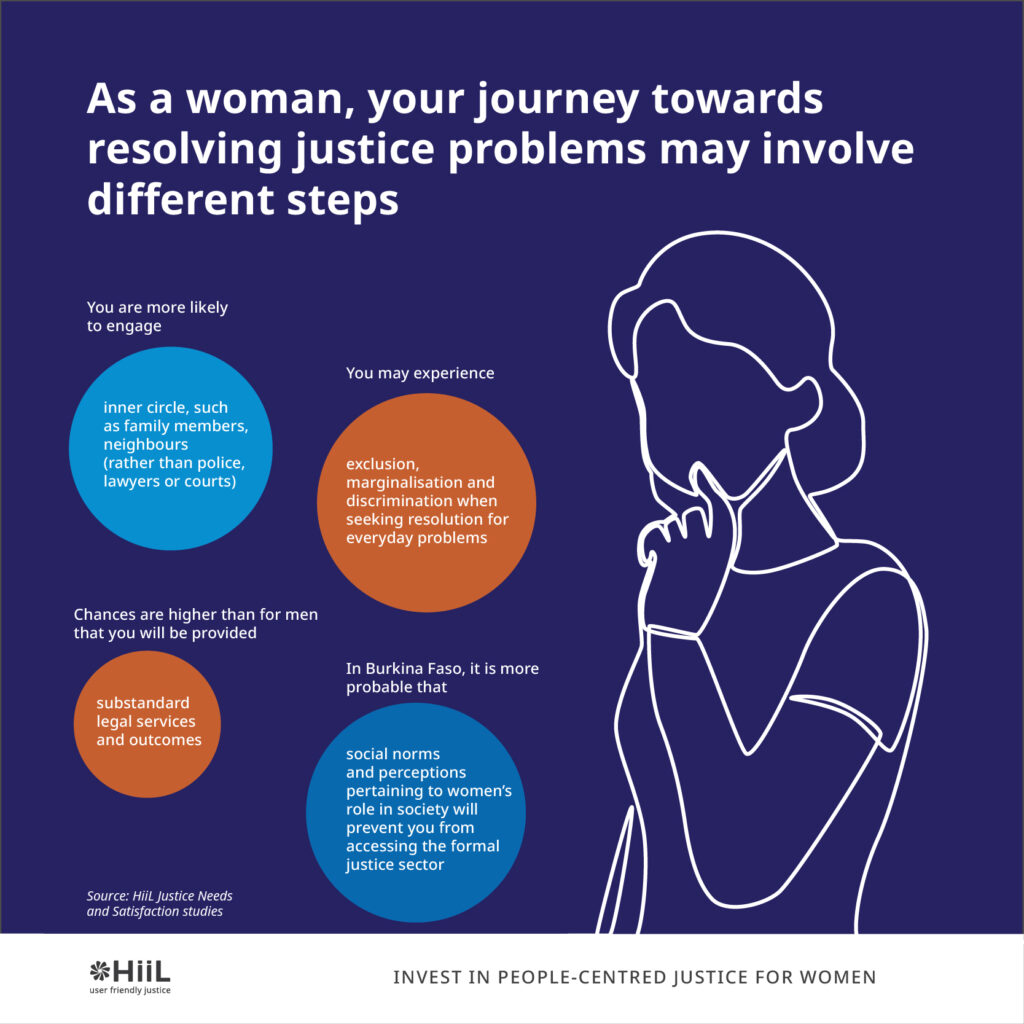By Zainab Malik and Rodrigo Nunez1
Justice systems globally fail to address the needs of women, perpetuating injustice and hindering economic progress and peace. People-centred justice offers a practical approach to closing the justice gap for women. In this article, we will lay out five key elements for a national people-centred justice programme to enhance women’s access to justice.

I. More Justice For Women, Better Economies, Societies
Justice providers cannot bridge national justice gaps without addressing the injustices suffered by virtually half their populations. When women have access to timely, effective, and affordable access to justice, they can manage their destinies, participate in the political, economic, and social life of their communities, live free from violence and discrimination, and, ultimately, contribute to the development of their communities. Global measures, like the Women, Peace and Security Index (WPS), show us that countries with higher scores for women’s justice are simply more peaceful, inclusive, prosperous, and even better prepared to adapt to climate change. There is, therefore, no question that justice for women is not just the right thing to do. It is also the best pathway to better economies, peaceful societies, and inclusive communities.
Around 50% of the world’s population, today, is left without any fair or just resolution for the legal problems they face every day. The burden of this justice gap falls disproportionately on women. Justice services are, simply, not designed to address women’s needs and experiences, nor do they aim to deliver the outcomes that women seek from resolution processes. This means that at each step in their journeys to access justice, women are faced with inequality of outcomes, discrimination and exclusion. For example, women, according to data, often turn to community or traditional justice leaders to resolve their problems. Unfortunately, these leaders frequently favour outcomes upholding marriage relationships or community-welfare over the well-being of women in abusive situations. Women are also more likely to be turned away without any solutions by police or other justice providers when seeking help for justice problems.
It is clear that justice providers need to rethink the way they are currently delivering justice to women. Progress made in advancing women’s education and health shows us, however, that with the right approach transformative progress is possible.
II. A People-Centred Justice Approach for Women’s Justice
People-centred justice (PCJ) is emerging as a new paradigm to help us deal with challenges under SDG 16.3 – equal access to justice for all. PCJ puts people and outcomes they want at the centre of justice systems, rather than institutions. It envisages a well-functioning justice system that delivers fast and effective justice services based on the plurality of needs and experiences of all the people it serves.
By moving the needs and justice journeys of women from the fringes to the centre of the design of justice systems, PCJ offers a practical approach to closing the women’s justice gap. It fosters an equal partnership between justice providers and women seeking justice, ensuring that services are responsive to women’s unique circumstances and consistently deliver the outcomes they want.
However, for PCJ to truly serve as a vehicle for delivering justice for women, there needs to be increased and targeted investment in data on women’s needs and experiences, understanding of what works for justice for women, and an enabling environment for the scaling of justice delivery models responsive to women.
In the following section, we lay out what a PCJ approach to enhance women’s access to justice would look like concretely by describing five key elements that would work together in an integrated manner at the national level. These elements would form the building blocks of a national people-centred justice program that can be implemented by justice providers, policy makers, civil society organisations and others to close the national justice gap for women.
A. Measuring The Justice Gap for Women: Data
Achieving justice for all requires a deep understanding of the most common justice problems that women and girls face, in addition to their experiences as they try to resolve them. Justice Needs and Satisfaction Surveys conducted by HiiL already provide us some key insights.
Our data shows that women face legal problems in roughly the same proportion as men. Usually, that is where the similarities end. In many countries, the types of legal problems women face tend to differ from those of men. For example, in Burkina Faso (2021) and Niger (2023) women are more likely to experience family-related problems, domestic violence and neighbour-related problems. Results from Tunisia (2023) show that women report problems with access to public services more often than men. The majority of these relate to accessing healthcare and education.
The most common consequences of legal problems for both men and women are usually loss of time and money. Women, however, are more likely to report facing violence and damage to family relations (Burkina Faso 2021) as a result of the legal problems. Negative emotions (USA 2020), and stress-related illness (Nigeria 2023) are also heavy consequences that women tend to experience more than men.
To resolve their most serious legal problems, whom do women typically turn to? Country data suggests that women rely more on their inner circle (family members, neighbours) while men tend to engage justice providers such as the police, lawyers, or even courts. Qualitative data from Burkina Faso shows that social norms and perceptions pertaining to women’s role in society serve as barriers to their accessing the formal justice sector. These findings suggest that the outcomes of initiatives focusing on formal justice sectors may not reach women.
Justice providers operate in a social context. For women, this is reflected in experiences of exclusion, marginalisation and discrimination when seeking resolution for everyday problems. Data shows that women are provided substandard services and outcomes in comparison to men. These results become more pronounced when considering the overlapping identities that influence women’s experiences of injustice. HiiL’s latest survey of populations affected by displacement in Iraq shows that when taking action to resolve their most serious legal problem, 26% of the women said the justice provider they chose did not help them (as opposed to 15% of the men).
In contexts of insularity and remoteness, the justice journeys of women suffer. According to the JNS Fiji 2019, 1/3rd of victims of domestic violence do not take any action. Victims, often, remain passive because they lack faith in their abilities to find a fair resolution. Shame, social stigma and the uneasy transition from formal to informal institutions are other barriers. This suggests that the integration between traditional justice systems with the formal justice systems should be a priority. A PCJ approach requires designing interventions that focus on empowering community-level justice services that are more accessible for women.
There is more to know. Data gaps still exist. It is imperative to uncover the reality of the justice journeys of women from the beginning until the end. We have to hear their voices and stories. The best moment to do this was decades ago. The second best moment is now.


B. What works for women: Evidence-based Practice
Knowledge about “what works” is a crucial ingredient for a people-centred justice system which aims to provide access to justice for all. Evidence-based practice has been an important driver of effectiveness in the health sector. By focusing research on women’s bodies and building out this evidence base on women’s health, scientists and doctors have seen improvements in health outcomes and overall quality of life for women, all while also seeing higher returns on investment in funding. Developing evidence-based treatments to deliver the outcomes desired by women seeking to resolve their justice problems can lead to bigger gains in bridging the justice gap for all. This can be illustrated by looking at the problem of Domestic Violence.
Domestic Violence legislation, particularly when narrowly focused on punishment, has had limited success in delivering what survivors define as justice. HiiL’s research in the Netherlands, Uganda and Nigeria shows that survivors of Intimate-partner Violence consistently prioritise holistic outcomes such as economic independence and improved physical and mental health. However, most justice providers (such as lawyers) are only equipped to provide support in applying for protection orders or filing for divorce or separation.
A survivor-centred approach to addressing Domestic Violence requires, firstly, defining and standardising outcomes to be measured and monitored based on the experiences of domestic violence survivors. Once outcomes have been defined, knowledge can be translated into guidelines for responding to domestic violence in a way that is agreed (or accepted) between the justice providers and those they are seeking to help. Recommendations on ‘what works’ in which situation can subsequently be applied by the many front-line providers who help people in the same situation.
This approach empowers survivors by making their voices heard throughout the resolution process. It is, thus, in sharp contrast to their reported experiences of secondary victimisation, disempowerment and demoralisation when seeking justice through adverserial justice system.
C. Game-changing Services that deliver for women
People-centred justice requires the delivery of innovative justice solutions that are effective, affordable, and sustainable. These innovative justice services help to bridge the access to justice gap by helping people easily and effectively navigate their justice journeys and find justice outcomes that they deserve. These solutions need to be supported by sustainable financial models and organisational structures to deliver impact.
Justice innovations such as the One-stop shop models create a safe and supportive environment for women and girls to seek immediate protection, medical treatment and legal assistance. In Ogun State (Nigeria), HiiL convened a Justice Innovation Lab to address domestic violence problems. The Lab led to the development of Ibi-Isadi (or a place of refuge) – a one-stop model that empowers communities in Ogun State through increased access to tailored legal information and advice, facilitating better referrals between survivors and providers (both formal and informal), and enhancing the capabilities of justice providers in preventing and resolving domestic violence problems in an evidence-based manner. Community Justice models are accessible, legitimate and provide fast and affordable solutions.
Data shows that women prefer turning to their immediate social environments when seeking actions, but fail to access information that is credible and tailored to their situation. Community justice services, under the right circumstances, can fill this gap. Like all delivery models, community justice services need to be supported with sustainable and innovative delivery models to make an impact.
Women-led startups and entrepreneurs have been at the forefront of providing services addressing women’s justice needs. Through the Justice Accelerator Program, HiiL has supported startups to develop Prevention Services like THR media and Stand to End Rape, that support survivors of gender-based violence to have access to legal information and support.
D. Enabling Environment
Deploying a people-centred justice approach that works for women requires an enabling environment. Currently, regulations in the justice sector act as gatekeepers, keeping people-centred justice service innovations from entering. People are forced to turn to adversarial dispute resolutions that consistently deliver unequal outcomes for women. To enable new, better models for delivering justice services, especially those that have proven to work for women, justice leaders must create an enabling regulatory and legal framework where innovation can thrive. Budgets for Ministries of Justice and Judiciaries need to be made more outcomes-focused based on women’s needs. New financing tools need to be implemented to support R&D and the scaling of the best resolution mechanisms. Allowing national investment and cooperation funding to leverage on each other. And, finally, setting up mechanisms that support cross-sectoral collaboration and shared goal setting.
E. Movement
Bridging the women’s justice gap is an uphill task that cannot be tackled by one ministry, court, or organisation on its own. It must be supported by a cohort of do-ers. The good-news is that a movement is growing. Women’s rights organisations have for a long time raised the alarm on the failure of the justice system to address women’s concerns and needs and have taken steps to bridge the justice gaps, for example, the Federation of Women Lawyers across the world. Over the years, several actors have joined the movement and taken up the call for better access to justice for women. International coalitions such as the Justice Action Coalition (JAC) are advocating for countries to adopt people-centred justice approaches. Multilateral organisations such as UN Women, UNDP, the World Bank and the International Development Law Organisation (IDLO) through their Justice for Women report are building knowledge. What we need is investment in people-centred justice approaches to advance women’s access to justice globally.
III. Investing in PCJ for women
There is currently an annual funding gap of USD 360 Billion for achieving gender equality across SDGs. Strengthening the rule of law has been a major priority for governments for several decades, but only a fraction of funding is being spent on justice for women. Deploying people-centred justice programmes to bridge the justice gap for women does not necessarily require spending more money, it only asks that current funding is used in a smarter way. Governments, in partnership with the private sector and philanthropy, can measure their return on investment in people-centred justice approaches for women as a measurement of positive outcomes for individuals, families, communities, businesses and society as a whole. We already know that gender parity in the workforce could inject an estimated US$12 trillion into the global GDP by 2025. Women’s access to land is also associated with better outcomes on multiple economic and development fronts.
Innovative financing initiatives are one way in which the funding gap for justice for women can be filled. Through mechanisms such as social impact bonds, gender lens investing, and other alternative financing solutions, there is an opportunity to mobilise private capital specifically towards addressing the multifaceted inequalities that hinder women’s access to justice and economic rights. The shift towards innovative financing signifies a departure from traditional financial frameworks that focus on completion of activities towards leveraging the achievement of outcomes furthering women’s access to justice.
The Orange Movement (named for the colour hue of SDG5 – Gender Equality) catalyses innovative financial models to help close the critical funding gap in women’s empowerment for micro, small and medium enterprises that deliver products and services for enhanced Justice endeavours. It aims to mobilise $10 billion by 2030 toward catalysing the empowerment of 100 million women, girls, and gender minorities, thereby taking us nearly halfway toward fast-tracking global gender equality and empowerment. To guide its efforts the movement published The Orange Bond Principles (OBPs) as part of its Orange Bond Initiative with a multi-stakeholder collaboration with input from over 100 ecosystem actors and designed to fit ICMA’s sustainable bond guidelines. The Women’s Livelihood Bond series (WLBs) is a pioneering financial instrument, first in the growing Orange asset class, issued by Impact Investment Exchange, that has mobilised a total of US$228 million, impacting 2.6 million women and girls. Another example is Orange Loan Facilities offering tailored lending products to support enterprises that empower women by providing flexible lending products at rates that adjust based on the borrower’s impact performance, like the example of gender empowerment. With the assistance of an Orange Loan, Champei – a small-hold farmer – was able to access climate-resilient agricultural training and resources, increasing her yield by 60% and her income by 50%.
The momentum towards gender lens investing is expanding, incorporating innovative methods like impact bonds. This global shift is evidenced by diverse initiatives: social impact bonds in sub-Saharan Africa, investment funds in Asia, microfinance in Latin America, and equality bonds in Europe and North America.
IV. Looking ahead
Women’s access to justice is a key enabler for better economies, peaceful societies, and inclusivity. It is no secret that women, especially those from vulnerable and disadvantaged groups, have been left behind in experiencing the benefits of existing justice programs. Too much focus on institutions, has meant the women’s needs and experiences have not found their way into the design of justice services. A new approach – people-centred justice- offers a pathway for redesigning justice systems to deliver just and fair outcomes for women, whilst providing them a voice in prevention and resolution processes.
A growing movement of do’ers are taking action with the new approach. They urgently need the support from knowledge and implementation partners and from funders and they need support to gradually realign systems and incentives, including financial incentives, to ensure that people-centred justice outcomes take centre stage. The time to invest in people-centred justice for women is now.
We would like to extend special thanks to the Orange Movement for their valuable insights and contributions to this article.
- The authors are Senior Justice Sector Advisors at The Hague Institute for Innovation of Law (HiiL) ↩︎

